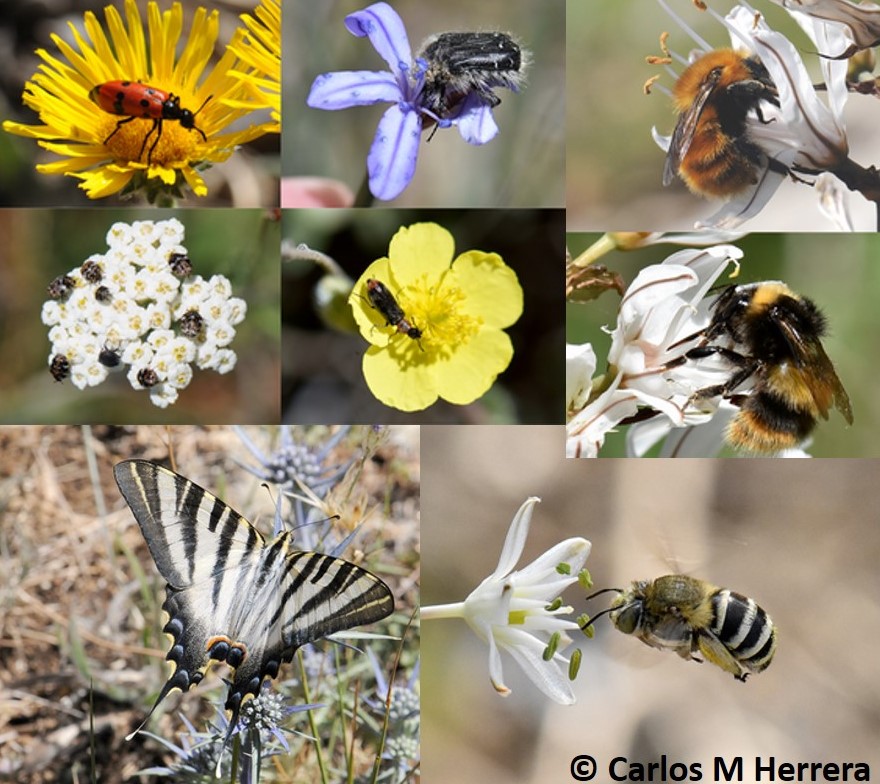Pollinator service is essential for successful sexual reproduction and long-term population persistence of animal-pollinated plants, and innumerable studies have shown that insufficient service by pollinators results in impaired sexual reproduction ("pollen limitation"). Studies directly addressing the predictors of variation in pollinator service across species or habitats remain comparatively scarce, which limits our understanding of the primary causes of natural variation in pollen limitation. This paper evaluates the importance of pollination-related features, evolutionary history and environment as predictors of pollinator service in a large sample of plant species from undisturbed montane habitats in southeastern Spain. Quantitative data on pollinator visitation were obtained for 191 insect-pollinated species belonging to 142 genera in 43 families, and the predictive values of simple floral traits (perianth type, class of pollinator visitation unit, and visitation unit dry mass), phylogeny, and habitat type were assessed. A total of 24,866 pollinator censuses accounting for 5,414,856 flower-min of observation were conducted on 510 different dates. Flowering patch and single flower visitation probabilities by all pollinators combined were significantly predicted by the combined effects of perianth type (open vs. restricted), class of visitation unit (single flower vs. flower packet), mass of visitation unit, phylogenetic relationships, and habitat type. Pollinator composition at insect order level varied extensively among plant species, largely reflecting the contrasting visitation responses of Coleoptera (beetles), Diptera (flies), Hymenoptera (bees) and Lepidoptera (butterflies) to variation in floral traits. For example, Lepidoptera responded positively to increasing mass of visitation unit in species with flowers packets, but negatively in species with single flowers and restrictive perianths. Pollinator composition had a strong phylogenetic component, and the distribution of phylogenetic autocorrelation hotspots of visitation rates across the plant phylogeny differed widely among insect orders. Habitat type was a key predictor of pollinator composition, as major insect orders exhibited decoupled variation across habitat types in visitation rates. Comprehensive pollinator sampling of a regional plant community has shown that pollinator visitation and composition can be parsimoniously predicted by a combination of simple floral features, habitat type and evolutionary history. Ambitious community-level studies can help to formulate novel hypotheses and questions, shed fresh light on long-standing controversies in pollination research (e.g., "pollination syndromes"), and identify methodological cautions that should be considered in pollination community studies dealing with small, phylogenetically-biased plant species samples. informacion[at]ebd.csic.es: Herrera (2019) Flower traits, habitat, and phylogeny as predictors of pollinator service: a plant community perspective. Ecol Monographs DOI 10.1002/ecm.1402
https://esajournals.onlinelibrary.wiley.com/doi/10.1002/ecm.1402  Latest News
Latest News
 Las altas temperaturas están provocando que las lagunas y las marismas de Doñana pierdan agua rápidamente
Las altas temperaturas están provocando que las lagunas y las marismas de Doñana pierdan agua rápidamente
La superficie inundada en la marisma es de un 78% pero la profundidad es escasa. Por otra parte, sólo el 1,9% de las lagunas temporales están inundadas. Las precipitaciones crean una oportunidad...
 Traffic noise causes lifelong harm to baby birds
Traffic noise causes lifelong harm to baby birds
A study with CSIC participation reveals for the first time that car noise harms individuals throughout their lifetime even years after exposure
 Illegal wildlife trade, a serious problem for biodiversity and human health
Illegal wildlife trade, a serious problem for biodiversity and human health
A research team led by the Doñana BIological Station and the University Pablo de Olavide have detected wild-caught pets in 95% of the localities in the Neotropic and warns of the risk of zoonotic...
 Urbanization and loss of woody vegetation are changing key traits of arthropod communities
Urbanization and loss of woody vegetation are changing key traits of arthropod communities
Urbanization is favouring smaller beetle species and larger spider species with greater dispersal capacity.
The loss of woody areas is linked to a decline in the duration of the activity...
The loss of woody areas is linked to a decline in the duration of the activity...
 Blood lead levels in an endangered vulture species decreased following restrictions on hunting practices
Blood lead levels in an endangered vulture species decreased following restrictions on hunting practices
Canarian Egyptian vulture was on the verge of extinction at the end of the 20th century. At that time, studies revealed that lead poisoning was a serious problem for the population’s survival. The...
— 5 Items per Page
 Asset Publisher
Asset Publisher
Back






